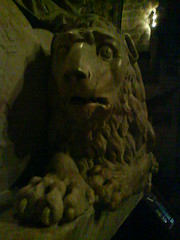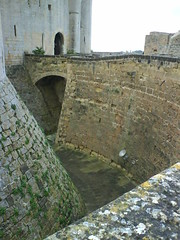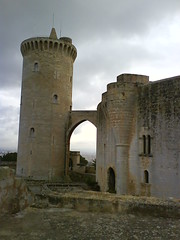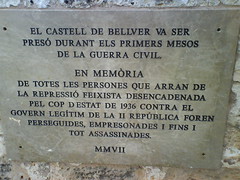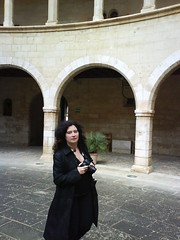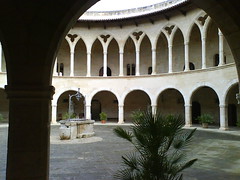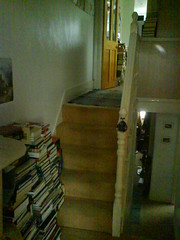So what to to make of Watchmen? I loved the comic in my teens (though not as much as I loved V For Vendetta), and recall the bloke who wrote Batman (1989) and Terry Gilliam both saying it could never be filmed. It's complex and strange, packed full of incident and the juxtaposition of repeated images. So any film would surely just be not quite as good as the source. Which is what's happened whenever they've put Alan Moore's other great comics on screen.
And yet for the most part I think Watchmen works as a movie. It's complex and strange and I keep picking over it like with the gap between my teeth. There's an awful lot that I like – Rorshach's mask and his performance, the opening titles, the look and feel of Archie. But there's also much that is bothersome...
Spoilers
obviously
follow
for
both
the
comic
and
the
film...
The choice in any adaptation is what to keep and what to cut out. Director Zack Snyder has slavishly kept close to the source: it's evident Dave Gibbons' artwork has been used to storyboard the film, and whole sections of the film's dialogue are lifted from the comic's balloons.
I'm surprised by how much of the comic makes it into the film. In fact, it feels too long at two-and-a-half hours. They could have cut back more.
The change to the ending in the comic keeps things simpler, and cuts out a whole sub-plot about pirate comics and a writer off making a movie. Veidt setting up Dr Manhattan works better than the comic's faked alien menace anyway. It makes Manhattan's slow separation from humanity part of the plot rather than an intriguing aside.
But my major concern is not with what's been taken out but added. In the comic, the murder of the Comedian is shown in the first four pages, in flashback, pressed in between panels of the cops looking round over the dead man's flat. Eddie Blake doesn't have a chance to fight back.
In the movie, there's a whole martial arts sequence like out of any superhero movie. Blake goes out fighting, punching through bricks and the kitchen cabinets, revealing super-human speed and strength. It misses something fundamental about what the comic's doing: grounding the outlandish events and characters in a grubby, mundane reality. These heroes are (for the most part) ordinary mortals. They're as fallible, flawed and falling apart as the rest of us.
The film's costumed heroes sport the same PVC chic as the comic-book movies since Batman in '89. They fight in the same ways as other comic-book movies, and there are the same fast CGI pull-backs to reveal huge buildings and landscapes. As a result it feels like a response to those movies: more about the X-Men of the 21st century than the 1980s.
That's not helped by the music. I know a few people who love the film's music, but I found the choices of tune just odd. It doesn't give any sense of the period: Bob Dylan and Jimi Hendrix both suggest the 60s. “All along the watchtower” is used in Withnail & I to a much better effect.
While the comic had a very particular sense of its period – an alternative, awful “now” - the film is a mish-mash of the nostalgic and contemporary, and neither quite feels right. If only it could have felt more like the brilliant title sequence, showing American history with the added bonus of heroes. Well, brilliant but for one little grumble.
The sequence shows assassination of JFK and then shows the Comedian wielding the rifle. It's a crass realisation of what in the comic is just an aside, the Comedian boasting to some mates at a party.
Too often the film favours the crass and simplistic over the more intriguing and complex. Laurie tells her mother she loves her, while in the comic those words never need to be said because its implicit in the scene.
The Dr was concerned by the not-quite-brilliant qualities of the actresses playing Laurie and her mum. But there’s no subtlety in their dialogue to play off: they seem awkward and stupid for stating the bleeding obvious.
More than that, special effects movies mean playing to green curtains and ping-pong balls on sticks. The film's editor can be more thrilled by the assembly of the disparate elements of the shot than the quality of performance. Just as Dr Manhattan sees human beings and their feelings as merely some tricky jigsaw. (See also the affect on Star Wars once technology let George Lucas build his empire whatever way he liked.)
It also doesn't help how “false” a lot of the film feels. The comic is grounded in realism: heroes who get dementia and drunk, who get old and die. There's something still strange and disturbing about superheroes being drafted into the war in Vietnam. In the film, the Nam sequences felt especially contrived, more Photoshop than photo realism.
There's been some mocking of the prosthetics and President Nixon's nose. The film makes more of him – and Kissinger – than the comic does, which diminishes his impact. He's a weird caricature in the film, a credible world leader bent under terrible pressure when we glimpse him in the comic – where he never says a word. There's nothing in the comic I can think of that Nixon's estate might want to sue.
The film also gets in a gag about Americans not accepting a cowboy into the White House. To do this they fudge a better gag in the comic, where it's Robert Redford standing for election in 1988. Would Reagan have been well enough to stand in ’88? And surely the point about Redford is he offers an alternative to the hard-line Republicanism Nixon represents in this world. The film throws out the political reality in favour of a cheap gag.
Likewise, Ozymandias says in the film that he's “not a comic book villain”, when that's plainly what he is. In the comic its “republic serial villain” because in a world where there are real superheroes, they don’t feature in comics. Again, the film loses out by putting things so bluntly.
The comic is violent but this is more so: there are extended and bigger fight scenes, a man having his arms cut off where he's just quickly stabbed in the comic, Dr Manhattan not just disintegrating people but spattering them all over the ceiling.
While the comic shows sex and bosoms and a full frontal blue willy, in the film it feels much more like titillation. Like some of the swearing in the first series of Torchwood (or when I took over Benny) this desperate effort to appear more adult just makes it seem more adolescent. The sex scene between Dan and Laurie should have felt more like the one in Don't Look Now: no soft focus, unglamorous, tender.
But the film also pulls its punches. The scenes of devastated New York are much bloodier in the comic. Even the “clean” nuclear explosion would leave people burned and horribly disfigured. Perhaps this film plays to a modern audience's subconscious horror of 9/11 (I was surprised not to see the Twin Towers collapse in that final attack), but it didn’t seem horrific enough. We need to be utterly appalled by what Veidt has done for the moral conundrum of the last scenes to carry any weight. It's not enough in the film that one of those killed in New York is Rorschach's psychologist. The comic introduces a whole load of familiar faces, and we don't even know their names.
It's a bold film full of flickers of brilliance. This great long post suggests I didn't enjoy it when I largely did. But I keep thinking how it might have been done differently. How the same cast and crew made a better version. Just in a world not that different from our own...
Wednesday, March 11, 2009
Monday, March 09, 2009
Come dancing
All over London there are posters for incredible India, exhorting you to "dance with the locals."
Did we learn nothing from Siegfried and Roy? They're not dancing, they're having a scrap. That's what cats do.
Or has incredible India got hold of some lipstick tigers?
Did we learn nothing from Siegfried and Roy? They're not dancing, they're having a scrap. That's what cats do.
Or has incredible India got hold of some lipstick tigers?
Sunday, March 08, 2009
A good, original idea
Merely 12 years late, I’ve read Garry Jenkins’ book on the making of the first three Star Wars films. (A lifetime ago at a Doctor Who convention in Manchester the weekend that Tony Blair became Prime Minister, eager fans were getting the pristine book signed by Maurice Bronson.)
I love Star Wars. I love the prequels. I can see flaws and problems in all the movies, but that doesn’t change how much I love them. Love isn’t blind: it sees the flaws and loves anyway.
For the most part, this book tells a familiar story of triumph against adversity, of a small band of believers proving wrong all the Men who said “no”. That story’s been re-told in the DVD documentaries and in the puffery for the three prequels. So time has dulled some of Jenkins’ exclusives.
His real coup is getting detail – and photographs – from Gary Kurtz, who produced the first two movies. Kurtz seems to have taken the fall for the troubled production of The Empire Strikes Back. But the thing I found most interesting was the affect of the first film’s success – the toll it took on cast and crew’s lives, and the trouble it caused in making the next two movies.
He is good at explaining the content of the times and the studio system, and how odd Lucas’ feel-good, expensive nonsense would have looked on paper. He’s also good at explaining Lucas’ canny – indeed revolutionary – attitude to merchandising, from the nascent idea of “Star Wars Stores” flogging product like Disney to the $2 billion deal with Pepsi in 1996 to “carry Star Wars characters on its products for the next five years” (p. 287).
There are plenty of fun details. Director Richard Marquand, for example, was the one responsible for revisiting – not just referring to – Yoda in Jedi. There’s the mischief caused by Carrie Fisher’s bosoms – bouncing around bra-less in A New Hope disrupting any scenes where she had to run, and escaping he metal bikini six years later in Jedi. And there’s Lucas’ great embarrassment at being asked how “Chewbacca and his family reproduced” (p. 240).
While there’s some acknowledgement of mistakes made, this is a success story. There’s no mention of the Star Wars Holiday Special or of the two Ewok movies. But the strangest thing about this story of Lucas fighting the man is him building his own empire in response. Valerie Hoffman, who embarrassed Lucas by asking about the sex lives of Wookies,
Jenkins finishes the book with word of the forthcoming three prequels – to be released, he says, in 1999, 2001 and 2003.
I love Star Wars. I love the prequels. I can see flaws and problems in all the movies, but that doesn’t change how much I love them. Love isn’t blind: it sees the flaws and loves anyway.
For the most part, this book tells a familiar story of triumph against adversity, of a small band of believers proving wrong all the Men who said “no”. That story’s been re-told in the DVD documentaries and in the puffery for the three prequels. So time has dulled some of Jenkins’ exclusives.
His real coup is getting detail – and photographs – from Gary Kurtz, who produced the first two movies. Kurtz seems to have taken the fall for the troubled production of The Empire Strikes Back. But the thing I found most interesting was the affect of the first film’s success – the toll it took on cast and crew’s lives, and the trouble it caused in making the next two movies.
“‘The problem with being a hit was that no one was going to work for the minimum, they all wanted top dollar,’ said Kurtz. Eventually Kurtz was given the $18 million he needed [to produce Empire]. Lucas would not allow him to forget whose money it was, however.”Stars were having problems with their new-found stardom, with drugs and whether their directors liked them. Crew struggled to meet the perfectionist demands of the rebel in charge. At one point, late on, Lucas changed his mind on a second alien race on Endor, and all the work on the yuzzums was for nothing. Jenkins’ skill is in showing the cost of the films’ success.Garry Jenkins, Empire building – the remarkable real life story of Star Wars, p. 213.
He is good at explaining the content of the times and the studio system, and how odd Lucas’ feel-good, expensive nonsense would have looked on paper. He’s also good at explaining Lucas’ canny – indeed revolutionary – attitude to merchandising, from the nascent idea of “Star Wars Stores” flogging product like Disney to the $2 billion deal with Pepsi in 1996 to “carry Star Wars characters on its products for the next five years” (p. 287).
There are plenty of fun details. Director Richard Marquand, for example, was the one responsible for revisiting – not just referring to – Yoda in Jedi. There’s the mischief caused by Carrie Fisher’s bosoms – bouncing around bra-less in A New Hope disrupting any scenes where she had to run, and escaping he metal bikini six years later in Jedi. And there’s Lucas’ great embarrassment at being asked how “Chewbacca and his family reproduced” (p. 240).
While there’s some acknowledgement of mistakes made, this is a success story. There’s no mention of the Star Wars Holiday Special or of the two Ewok movies. But the strangest thing about this story of Lucas fighting the man is him building his own empire in response. Valerie Hoffman, who embarrassed Lucas by asking about the sex lives of Wookies,
“had been hired as a secretary in the aftermath of Star Wars, and began her working days in a caravan. ‘The minute we moved into the new building [in 1979] there was a dress code.’”And there are plenty of loyal believers who fought alongside Lucas who are then left out in the cold. It’s a success story with an oddly bitter taste. Jenkins himself links the affect of Lucas’ divorce to the quality of Jedi. Marcia Lucas helped edit all three films.Ibid., p. 240.
“Yet, perhaps significantly, the emotional credibility she had always given her husband’s films – ‘the dying and crying’ as he called it – was absent [from Jedi].”The effects and monsters might all have come out as he wanted in this last one, but the heart had maybe been lost...Ibid., p. 274.
Jenkins finishes the book with word of the forthcoming three prequels – to be released, he says, in 1999, 2001 and 2003.
“Casting director Robin Gurland had been focussing on young actors for the parts of the young Anakin Skywaker, Obi-Wan Kenobi and a young Queen, presumably Luke and Leia’s mother. Ironically it was the role of Obi-Wan Kenobi that became the only one connected with an established name. A persistent, not to say intriguing, rumour that Kenneth Branagh had signed up for the role failed to disappear even after an official denial from Lucasfilm.”He says Lucas will need “a flash of magic beyond even his marketing and merchandising millions” for the prequels to succeed. But I felt he’d already identified those unmade movies’ major flaw...Ibid., p. 288.
Friday, March 06, 2009
Sara 2 Kingdom
The new issue of Doctor Who Magazine announces I've written "The Drowned World" for release in July 2009. It will star Jean Marsh as the Doctor's old (and, er, dead) friend Sara Kingdom, and is a direct sequel to my Home Truths.
The same issue includes an as-ever-brilliant article by Andrew Pixley on how close Sara got to starring in her own Dalek TV series on American telly in the 60s. Cor.
And the reviews have generally nice things to say about some of my stuff: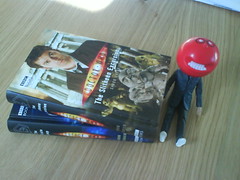 In other news, issue #105 of Doctor Who Adventures features a comic strip written by me, "Secret Army". I've received my first copy of The Slitheen Excursion.
In other news, issue #105 of Doctor Who Adventures features a comic strip written by me, "Secret Army". I've received my first copy of The Slitheen Excursion.
And tomorrow I'll be manning the Big Finish stall at Time Quest in Barking. Do say hello if you're there. And also if you're not.
The same issue includes an as-ever-brilliant article by Andrew Pixley on how close Sara got to starring in her own Dalek TV series on American telly in the 60s. Cor.
And the reviews have generally nice things to say about some of my stuff:
"Smart and intriguingly structured, The Prisoner's Dilemma is an essential appendix to the Key 2 Time plays."and
"[The Judgement of Isskar] is solid stuff, if becoming slightly convoluted in the second half as various insect and Martian factions squabble. It ends on a great cliffhanger leaving me eagerly awaiting the search for the next segment."SFX, meanwhile, gives Isskar an above-average 3 out of 5 stars.Matt Michael, The DWM Review, Doctor Who Magazine #406 (1 April 2009), p. 62.
"With heaps of intrigue and incident, it's lively stuff but the bizarre structure leaves it feeling like three separate stories welded together".Saxon Bullock, RATEDmisc, SFX #179 (February 2009), p. 130.
 In other news, issue #105 of Doctor Who Adventures features a comic strip written by me, "Secret Army". I've received my first copy of The Slitheen Excursion.
In other news, issue #105 of Doctor Who Adventures features a comic strip written by me, "Secret Army". I've received my first copy of The Slitheen Excursion.And tomorrow I'll be manning the Big Finish stall at Time Quest in Barking. Do say hello if you're there. And also if you're not.
Labels:
big finish,
comics,
droo,
public engagements,
stuff written
Thursday, March 05, 2009
Palma chameleon
Arrived in Palma on Sunday evening, guests at the Mallorca Marriott Son Antem Golf Resort and Spa. They rang up a few months ago on the basis of all the Marriott's I've stayed in over the years, offering a cheap break on condition me and the Dr sat through a pitch from them. We thought what the hell.
Surprised by how rude a lot of the passengers were on the Easyjet flight, barking and snapping at the staff as if they thought they were going first class. We taxied to the hotel to find it was packed out with golfing Germans. So the hotel offered us one of their three-bedroom villas with a bathroom each. Just the downstairs was bigger than our flat at home, with a jacuzzi bath and a telly in every cupboard.
Perhaps this was part of the pitch they were going to make us - it just seemed to good to be true. We unpacked, we bought some food and we sat outside and read The Graveyard Book. When it got too cold to be outside, the Dr cooked and I discovered our tellies oddly got BBC One and Three. So we got to watch the finale of Being Human.
Got up Monday and collected our welcome pack: a bottle of wine, a map of Palma and Mallorca, some coupons for the spa and other Marriott hotels, and a list of restaurants and beaches. The nice bloke reminded us of the pitch we'd have to attend the next day, and when I told him we'd not taken the hire car gave me advice on parking in Palma anyway.
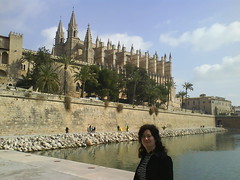 After a healthy breakfast, we grabbed a taxi in town. The sun was out and we basked under it, in view of the striking cathedral, La Seu.
After a healthy breakfast, we grabbed a taxi in town. The sun was out and we basked under it, in view of the striking cathedral, La Seu.
It's an oddly blocky oblongs, tall flying buttresses kept in tight, so it feels more like a mad design from a fantasy movie rather than a real gothic building. The Dr was especially excited that Antoni Gaudi had worked on tidying the place up at the turn of the twentieth century.
 We made our way up the steps and made our way round to the left of the cathedral, in between it and the Almudaina Palace. The front of the cathedral could almost be brand new: immaculate pale stone framing the darker, more weathered medieval original. I struggled to get the grand majesty of the front into the frame of my mobile.
We made our way up the steps and made our way round to the left of the cathedral, in between it and the Almudaina Palace. The front of the cathedral could almost be brand new: immaculate pale stone framing the darker, more weathered medieval original. I struggled to get the grand majesty of the front into the frame of my mobile.
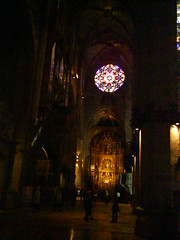 It was just €2.50 each to get in and we shuffled into the darkness. Yet the strangest thing about La Seu is that its so beautifully light.
It was just €2.50 each to get in and we shuffled into the darkness. Yet the strangest thing about La Seu is that its so beautifully light.
Gaudi, we learned from the book we bought afterwards, unbricked the windows and brought in electric candles, part of a general movement in the church in the time to build up the response of the congregation, a movement which led to Vatican 2 in the sixties.
Of course my phone doesn't pick up on half the subtleties of the light.
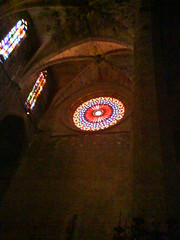 Here's the other side of the main window which I'd snapped from outside. The colours are bright and cheery, not like other so many churches in Spain which I felt seek to cower and terrify.
Here's the other side of the main window which I'd snapped from outside. The colours are bright and cheery, not like other so many churches in Spain which I felt seek to cower and terrify.
I realise I've not written up my notes on Seville and Cordoba from last September, but how different this simple grandeur is to the oppressive Catholicism of the Mesquita. The extraordinary thing there is the beauty of the original mosque, and the heavy-handed vulgarity of the Christian imposition.
 A lot of Spanish churches proclaim the patronage of the conquistadors and the awful power of the priests. In the Mesquita, that's like vandalism written in stone. And when you take pictures the architectural prowess of the Moors is even more self-evident. The Moorish bits shine in the natural, subtle light; the Catholic bits are dumped in their darkness.
A lot of Spanish churches proclaim the patronage of the conquistadors and the awful power of the priests. In the Mesquita, that's like vandalism written in stone. And when you take pictures the architectural prowess of the Moors is even more self-evident. The Moorish bits shine in the natural, subtle light; the Catholic bits are dumped in their darkness.
But La Seu is nothing like that. Yes, there's the grotesque, bloody statues of martyrs and sinners alike. But the efforts in the early twentieth century, such as Gaudi moving the choir stalls to nearer the altar, created a whole new sense of space.
 They're still working on the place; Gaudi's gold leaves around the altar shrouded by high scaffolding, reaching up into the heavens. Oddly, the workers up there had a radio on, and - muted yet still distinct - Robbie Williams' "Angels" curled round the cathedral.
They're still working on the place; Gaudi's gold leaves around the altar shrouded by high scaffolding, reaching up into the heavens. Oddly, the workers up there had a radio on, and - muted yet still distinct - Robbie Williams' "Angels" curled round the cathedral.
But there was something about the modern pop music that worked. It seemed to fit La Seu's historic embrace with modern art and design, to engage with the people who come through its doors and the everyday detail of their lives.
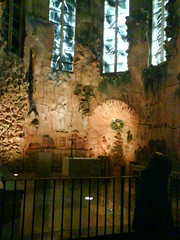 To the right of the main altar is a chapel recently done up in style. The windows are shaded in grey, the gothic brickwork hidden behind cracked plaster that suggests the seabed. I assume its acknowledging the debt that Palma - and the island - owes the sea, and the price its people have paid in those who've not come back from the water.
To the right of the main altar is a chapel recently done up in style. The windows are shaded in grey, the gothic brickwork hidden behind cracked plaster that suggests the seabed. I assume its acknowledging the debt that Palma - and the island - owes the sea, and the price its people have paid in those who've not come back from the water.
There's the suggestion of skulls under the altar itself, and amorphous creatures float round the walls, which might be angels or jellyfish. It's a haunting and strange place, and a bold commission for such a church. But I found myself lingering there, drawn by its strangeness, trying to puzzle it out.
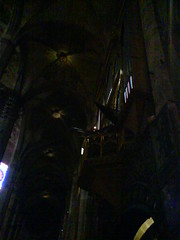 I then noticed the organ, set up high above the way we'd come in. Again it's oddly incongruous with the rest of the cathedral. My almost-black picture doesn't quite show how the pipes are arranged. There's a cluster of vertical tubes like most organs, then a line of horizontal ones striking out like a line of muskets or blunderbusses.
I then noticed the organ, set up high above the way we'd come in. Again it's oddly incongruous with the rest of the cathedral. My almost-black picture doesn't quite show how the pipes are arranged. There's a cluster of vertical tubes like most organs, then a line of horizontal ones striking out like a line of muskets or blunderbusses.
I've no idea if that's the intention, but the same thought struck the Dr independently. Perhaps she got better pictures...
 There was a fun Victorian monument as we made our way out. I ignored the poor dead bloke on the slab and the respectable chap mourning behind him. To the right was this lady who seemed rather bored by the whole thing. And at her feet nestled a lion with the most marvellous boggling expression:
There was a fun Victorian monument as we made our way out. I ignored the poor dead bloke on the slab and the respectable chap mourning behind him. To the right was this lady who seemed rather bored by the whole thing. And at her feet nestled a lion with the most marvellous boggling expression:
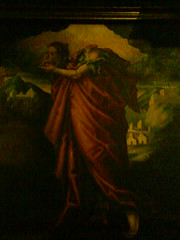 And lastly, there was a series of portraits telling the life stories of important saints. These can often be excitingly grisly, and sure enough the nearest panel shows a lady looking quite smug about having her head chopped off. Look at the smile on those innocent features. Behold her spurting neck.
And lastly, there was a series of portraits telling the life stories of important saints. These can often be excitingly grisly, and sure enough the nearest panel shows a lady looking quite smug about having her head chopped off. Look at the smile on those innocent features. Behold her spurting neck.
I'm never sure in these kind of narratives what the call to action is meant to be. Are you meant to look on this work and feel consumed by outrage that a saint's been killed? Or when you see the horrid things done to them because they did right by God are you meant to think, "That could be me!"? Wouldn't that rather put you off coming back to church?
 The sun awaited us outside. We emerged into cloisters with a good view back up at the buttresses, like seeing the tricks done backstage.
The sun awaited us outside. We emerged into cloisters with a good view back up at the buttresses, like seeing the tricks done backstage.
We filed out into the medieval streets and wandered a bit, looking in on a nice ornate garden, its pond stocked with bright, happy goldfish. We were making it up as we went along, no idea where we were going.
Then we made out way up the high street in the direction of the train station. It's funny seeing the familiar brand names and shops mixed up with things unique to a city. And I boggled at an advert in a shoe shop, not quite sure what it was trying to sell:
 We arrived at the main train station and the Dr remembered something about an old-fashioned train journey that would take us up into the mountains. Had to leave the modern station and cross a road to find what we were after.
We arrived at the main train station and the Dr remembered something about an old-fashioned train journey that would take us up into the mountains. Had to leave the modern station and cross a road to find what we were after.
The train to Soller first opened in 1912, and still uses authentic wooden trains from before the invention of leg room. We gleefully piled aboard, and spent the hour journey reading and staring out the window at the orange trees and scenery. Once you're out of the industrial bits of Palma its really very beautiful. A young couple a few rows ahead of us snogged every time we went into a tunnel, but the Dr and I are too long married and jaded for anything like that.
The weather was turning when we reached Soller, and we nosed round two small, free galleries showing original works by Miro and Picasso. Then there wasn't much to tempt us but okay enough places to eat, so we paid the €21 for a cab to Deia, where Robert Graves had lived.
Clambered our way to the top of the small, pretty town in the smattering of rain, but couldn't spot him in the graveyard. We found his widow, Beryl, who'd only died in 2003, and wondered whether Graves' grave was somewhere else. The Dr teased me that we'd be able to hear it if we were near; the spinning his response to what I've done to his myths.
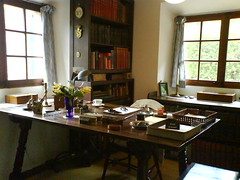 So instead we made our way back down the road to his house - now a little museum. We had about half an hour before the one bus back to Soller, so not loads of time to look round. But the keen girl on the gate took us into the garage to watch a short film full of BBC archive material and narrated as if by Graves himself. It was a bit harsh on Laura Riding, but didn't avoid discussing Graves' complicated love life. And dammit, his grave was up in that little church but we didn't have time to go back.
So instead we made our way back down the road to his house - now a little museum. We had about half an hour before the one bus back to Soller, so not loads of time to look round. But the keen girl on the gate took us into the garage to watch a short film full of BBC archive material and narrated as if by Graves himself. It was a bit harsh on Laura Riding, but didn't avoid discussing Graves' complicated love life. And dammit, his grave was up in that little church but we didn't have time to go back.
 We crossed through the neat garden of orange trees and into his simple house. There was his writing room, there the printing press that got him arrested and deported at the start of the Civil War. The Dr was surprised by the volume of communist literature in Beryl's study - and wondered how Graves could have been welcomed back to Mallorca after World War Two, for thirty years under Franco.
We crossed through the neat garden of orange trees and into his simple house. There was his writing room, there the printing press that got him arrested and deported at the start of the Civil War. The Dr was surprised by the volume of communist literature in Beryl's study - and wondered how Graves could have been welcomed back to Mallorca after World War Two, for thirty years under Franco.
She also felt that if one day our home is opened up to my legion of disciples, she'll leave special instruction not to leave it so tidy. Visitors will have to step over my discarded underpants and around the stacks of papers and mess.
The bus was 15 minutes late, and we were anxious we'd miss the last train back to Palma. We were even more anxious that the double-decker bus might survive the winding, mountainous roads. And then we failed to notice our stop and had five minutes of panic in Porte de Soller before getting back on the same bus which was heading back the way it had come. We were in Soller again in time for a beer and a sandwich, and to buy some home made white chocolate. Then the Dr slept on the train back to Palma and I read two-thirds of The Man Who Would Be King on her Sony e-reader.
 We nosed through the dark, atmospheric city looking for places to eat. It was a Monday so most places seemed closed, or perhaps we were just in the wrong area.
We nosed through the dark, atmospheric city looking for places to eat. It was a Monday so most places seemed closed, or perhaps we were just in the wrong area.
We followed our earlier footsteps back to the cathedral, hoping we'd find somewhere, and if not we'd get a taxi. The cathedral loomed beautifully in the quiet darkness and we stopped to take pictures. But our tummies were grumbly.
 But still there was nothing open. We passed down through government offices, sporting this sign which I thought was funny. "Bombers" means "firemen" rather than "terrorists".
But still there was nothing open. We passed down through government offices, sporting this sign which I thought was funny. "Bombers" means "firemen" rather than "terrorists".
After that, we found a brilliant place called Forn des Teatre on Pza Weyler for wine and tapas. There was gambas in plenty of garlic, and bocquerones and local cheeses and meat. Then a taxi back to our villa. As we pulled up into the resort complex, we felt slightly uneasy. The hotel is lavish and luxuriant, but it could almost be anywhere, a gated suburb outside of the real world. It seemed to have no connection with any of the history or people we'd seen that day. And on balance we'd have been happier living in a small town like Deia than this anonymous place...
So we were a little hesitant as we made our way next morning to the all-important pitch. The nice bloke was there and fixed us coffees, and explained that "timeshare" has a lot of negative connotations, so Marriott has worked up a flexible system with all kinds of options. He talked through them, but it was obvious pretty quickly that none of it was quite right for us. Neither of us really value holidays where you don't do anything.
It was all very genial, and it makes you feel quite adult to be there at all. But I felt a little like we'd been spotted as frauds or children. Afterwards, we went to the spa, and I wondered about the other people there. Did they all sign up to villas? Did they come back here every year?
I could see it would be good if you had young children to have a regular escape. Or if you liked golf, or wanted somewhere to retire too... There's comfort in the recognisable brand of the hotel chain and the high standards of customer service. But it's not just for us.
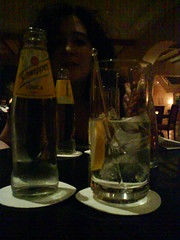 That night we drank in the hotel bar, enjoying lavish measures of gin. I'd not taken any work with me on purpose, but had made some notes for something I want to pitch someone, and was already thinking about getting back to work. At the moment it's called "Machine code", but I will not speak more of it just yet.
That night we drank in the hotel bar, enjoying lavish measures of gin. I'd not taken any work with me on purpose, but had made some notes for something I want to pitch someone, and was already thinking about getting back to work. At the moment it's called "Machine code", but I will not speak more of it just yet.
I guess a resort like this is great if you want to get away from the real world, to escape the tedium of work. I can see how you'd judge your success in a job by how much time you can get away. But again, it's not us. I miss writing when I away.
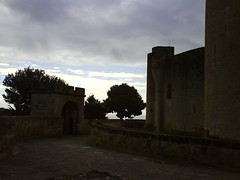 Tuesday looked grey as we packed our bags and I finished Pashazade. We checked out and got the taxi to the Castell de Bellver, overlooking Palma.
Tuesday looked grey as we packed our bags and I finished Pashazade. We checked out and got the taxi to the Castell de Bellver, overlooking Palma.
It took a bit of time to find our way in 'cos the taxi driver had directed us to a locked door. But then we were into a top-quality castle, with all kinds of clever defences. There were moats within moats and round walls to resist undermining, bridges across that had kinks in them, and other cunning ways to impede access. Inside there were exhibits of Roman sculpture and casts, which greatly pleased the Dr.
We wandered around for a couple of hours quite happily, and then had an easy lunch before cabbing it to the airport and wending our way home.
Surprised by how rude a lot of the passengers were on the Easyjet flight, barking and snapping at the staff as if they thought they were going first class. We taxied to the hotel to find it was packed out with golfing Germans. So the hotel offered us one of their three-bedroom villas with a bathroom each. Just the downstairs was bigger than our flat at home, with a jacuzzi bath and a telly in every cupboard.
Perhaps this was part of the pitch they were going to make us - it just seemed to good to be true. We unpacked, we bought some food and we sat outside and read The Graveyard Book. When it got too cold to be outside, the Dr cooked and I discovered our tellies oddly got BBC One and Three. So we got to watch the finale of Being Human.
Got up Monday and collected our welcome pack: a bottle of wine, a map of Palma and Mallorca, some coupons for the spa and other Marriott hotels, and a list of restaurants and beaches. The nice bloke reminded us of the pitch we'd have to attend the next day, and when I told him we'd not taken the hire car gave me advice on parking in Palma anyway.
 After a healthy breakfast, we grabbed a taxi in town. The sun was out and we basked under it, in view of the striking cathedral, La Seu.
After a healthy breakfast, we grabbed a taxi in town. The sun was out and we basked under it, in view of the striking cathedral, La Seu.It's an oddly blocky oblongs, tall flying buttresses kept in tight, so it feels more like a mad design from a fantasy movie rather than a real gothic building. The Dr was especially excited that Antoni Gaudi had worked on tidying the place up at the turn of the twentieth century.
 We made our way up the steps and made our way round to the left of the cathedral, in between it and the Almudaina Palace. The front of the cathedral could almost be brand new: immaculate pale stone framing the darker, more weathered medieval original. I struggled to get the grand majesty of the front into the frame of my mobile.
We made our way up the steps and made our way round to the left of the cathedral, in between it and the Almudaina Palace. The front of the cathedral could almost be brand new: immaculate pale stone framing the darker, more weathered medieval original. I struggled to get the grand majesty of the front into the frame of my mobile. It was just €2.50 each to get in and we shuffled into the darkness. Yet the strangest thing about La Seu is that its so beautifully light.
It was just €2.50 each to get in and we shuffled into the darkness. Yet the strangest thing about La Seu is that its so beautifully light.Gaudi, we learned from the book we bought afterwards, unbricked the windows and brought in electric candles, part of a general movement in the church in the time to build up the response of the congregation, a movement which led to Vatican 2 in the sixties.
Of course my phone doesn't pick up on half the subtleties of the light.
 Here's the other side of the main window which I'd snapped from outside. The colours are bright and cheery, not like other so many churches in Spain which I felt seek to cower and terrify.
Here's the other side of the main window which I'd snapped from outside. The colours are bright and cheery, not like other so many churches in Spain which I felt seek to cower and terrify.I realise I've not written up my notes on Seville and Cordoba from last September, but how different this simple grandeur is to the oppressive Catholicism of the Mesquita. The extraordinary thing there is the beauty of the original mosque, and the heavy-handed vulgarity of the Christian imposition.
 A lot of Spanish churches proclaim the patronage of the conquistadors and the awful power of the priests. In the Mesquita, that's like vandalism written in stone. And when you take pictures the architectural prowess of the Moors is even more self-evident. The Moorish bits shine in the natural, subtle light; the Catholic bits are dumped in their darkness.
A lot of Spanish churches proclaim the patronage of the conquistadors and the awful power of the priests. In the Mesquita, that's like vandalism written in stone. And when you take pictures the architectural prowess of the Moors is even more self-evident. The Moorish bits shine in the natural, subtle light; the Catholic bits are dumped in their darkness.But La Seu is nothing like that. Yes, there's the grotesque, bloody statues of martyrs and sinners alike. But the efforts in the early twentieth century, such as Gaudi moving the choir stalls to nearer the altar, created a whole new sense of space.
 They're still working on the place; Gaudi's gold leaves around the altar shrouded by high scaffolding, reaching up into the heavens. Oddly, the workers up there had a radio on, and - muted yet still distinct - Robbie Williams' "Angels" curled round the cathedral.
They're still working on the place; Gaudi's gold leaves around the altar shrouded by high scaffolding, reaching up into the heavens. Oddly, the workers up there had a radio on, and - muted yet still distinct - Robbie Williams' "Angels" curled round the cathedral.But there was something about the modern pop music that worked. It seemed to fit La Seu's historic embrace with modern art and design, to engage with the people who come through its doors and the everyday detail of their lives.
 To the right of the main altar is a chapel recently done up in style. The windows are shaded in grey, the gothic brickwork hidden behind cracked plaster that suggests the seabed. I assume its acknowledging the debt that Palma - and the island - owes the sea, and the price its people have paid in those who've not come back from the water.
To the right of the main altar is a chapel recently done up in style. The windows are shaded in grey, the gothic brickwork hidden behind cracked plaster that suggests the seabed. I assume its acknowledging the debt that Palma - and the island - owes the sea, and the price its people have paid in those who've not come back from the water.There's the suggestion of skulls under the altar itself, and amorphous creatures float round the walls, which might be angels or jellyfish. It's a haunting and strange place, and a bold commission for such a church. But I found myself lingering there, drawn by its strangeness, trying to puzzle it out.
 I then noticed the organ, set up high above the way we'd come in. Again it's oddly incongruous with the rest of the cathedral. My almost-black picture doesn't quite show how the pipes are arranged. There's a cluster of vertical tubes like most organs, then a line of horizontal ones striking out like a line of muskets or blunderbusses.
I then noticed the organ, set up high above the way we'd come in. Again it's oddly incongruous with the rest of the cathedral. My almost-black picture doesn't quite show how the pipes are arranged. There's a cluster of vertical tubes like most organs, then a line of horizontal ones striking out like a line of muskets or blunderbusses.I've no idea if that's the intention, but the same thought struck the Dr independently. Perhaps she got better pictures...
 There was a fun Victorian monument as we made our way out. I ignored the poor dead bloke on the slab and the respectable chap mourning behind him. To the right was this lady who seemed rather bored by the whole thing. And at her feet nestled a lion with the most marvellous boggling expression:
There was a fun Victorian monument as we made our way out. I ignored the poor dead bloke on the slab and the respectable chap mourning behind him. To the right was this lady who seemed rather bored by the whole thing. And at her feet nestled a lion with the most marvellous boggling expression: And lastly, there was a series of portraits telling the life stories of important saints. These can often be excitingly grisly, and sure enough the nearest panel shows a lady looking quite smug about having her head chopped off. Look at the smile on those innocent features. Behold her spurting neck.
And lastly, there was a series of portraits telling the life stories of important saints. These can often be excitingly grisly, and sure enough the nearest panel shows a lady looking quite smug about having her head chopped off. Look at the smile on those innocent features. Behold her spurting neck.I'm never sure in these kind of narratives what the call to action is meant to be. Are you meant to look on this work and feel consumed by outrage that a saint's been killed? Or when you see the horrid things done to them because they did right by God are you meant to think, "That could be me!"? Wouldn't that rather put you off coming back to church?
 The sun awaited us outside. We emerged into cloisters with a good view back up at the buttresses, like seeing the tricks done backstage.
The sun awaited us outside. We emerged into cloisters with a good view back up at the buttresses, like seeing the tricks done backstage.We filed out into the medieval streets and wandered a bit, looking in on a nice ornate garden, its pond stocked with bright, happy goldfish. We were making it up as we went along, no idea where we were going.
Then we made out way up the high street in the direction of the train station. It's funny seeing the familiar brand names and shops mixed up with things unique to a city. And I boggled at an advert in a shoe shop, not quite sure what it was trying to sell:
 We arrived at the main train station and the Dr remembered something about an old-fashioned train journey that would take us up into the mountains. Had to leave the modern station and cross a road to find what we were after.
We arrived at the main train station and the Dr remembered something about an old-fashioned train journey that would take us up into the mountains. Had to leave the modern station and cross a road to find what we were after.The train to Soller first opened in 1912, and still uses authentic wooden trains from before the invention of leg room. We gleefully piled aboard, and spent the hour journey reading and staring out the window at the orange trees and scenery. Once you're out of the industrial bits of Palma its really very beautiful. A young couple a few rows ahead of us snogged every time we went into a tunnel, but the Dr and I are too long married and jaded for anything like that.
The weather was turning when we reached Soller, and we nosed round two small, free galleries showing original works by Miro and Picasso. Then there wasn't much to tempt us but okay enough places to eat, so we paid the €21 for a cab to Deia, where Robert Graves had lived.
Clambered our way to the top of the small, pretty town in the smattering of rain, but couldn't spot him in the graveyard. We found his widow, Beryl, who'd only died in 2003, and wondered whether Graves' grave was somewhere else. The Dr teased me that we'd be able to hear it if we were near; the spinning his response to what I've done to his myths.
 So instead we made our way back down the road to his house - now a little museum. We had about half an hour before the one bus back to Soller, so not loads of time to look round. But the keen girl on the gate took us into the garage to watch a short film full of BBC archive material and narrated as if by Graves himself. It was a bit harsh on Laura Riding, but didn't avoid discussing Graves' complicated love life. And dammit, his grave was up in that little church but we didn't have time to go back.
So instead we made our way back down the road to his house - now a little museum. We had about half an hour before the one bus back to Soller, so not loads of time to look round. But the keen girl on the gate took us into the garage to watch a short film full of BBC archive material and narrated as if by Graves himself. It was a bit harsh on Laura Riding, but didn't avoid discussing Graves' complicated love life. And dammit, his grave was up in that little church but we didn't have time to go back. We crossed through the neat garden of orange trees and into his simple house. There was his writing room, there the printing press that got him arrested and deported at the start of the Civil War. The Dr was surprised by the volume of communist literature in Beryl's study - and wondered how Graves could have been welcomed back to Mallorca after World War Two, for thirty years under Franco.
We crossed through the neat garden of orange trees and into his simple house. There was his writing room, there the printing press that got him arrested and deported at the start of the Civil War. The Dr was surprised by the volume of communist literature in Beryl's study - and wondered how Graves could have been welcomed back to Mallorca after World War Two, for thirty years under Franco.She also felt that if one day our home is opened up to my legion of disciples, she'll leave special instruction not to leave it so tidy. Visitors will have to step over my discarded underpants and around the stacks of papers and mess.
The bus was 15 minutes late, and we were anxious we'd miss the last train back to Palma. We were even more anxious that the double-decker bus might survive the winding, mountainous roads. And then we failed to notice our stop and had five minutes of panic in Porte de Soller before getting back on the same bus which was heading back the way it had come. We were in Soller again in time for a beer and a sandwich, and to buy some home made white chocolate. Then the Dr slept on the train back to Palma and I read two-thirds of The Man Who Would Be King on her Sony e-reader.
 We nosed through the dark, atmospheric city looking for places to eat. It was a Monday so most places seemed closed, or perhaps we were just in the wrong area.
We nosed through the dark, atmospheric city looking for places to eat. It was a Monday so most places seemed closed, or perhaps we were just in the wrong area.We followed our earlier footsteps back to the cathedral, hoping we'd find somewhere, and if not we'd get a taxi. The cathedral loomed beautifully in the quiet darkness and we stopped to take pictures. But our tummies were grumbly.
 But still there was nothing open. We passed down through government offices, sporting this sign which I thought was funny. "Bombers" means "firemen" rather than "terrorists".
But still there was nothing open. We passed down through government offices, sporting this sign which I thought was funny. "Bombers" means "firemen" rather than "terrorists".After that, we found a brilliant place called Forn des Teatre on Pza Weyler for wine and tapas. There was gambas in plenty of garlic, and bocquerones and local cheeses and meat. Then a taxi back to our villa. As we pulled up into the resort complex, we felt slightly uneasy. The hotel is lavish and luxuriant, but it could almost be anywhere, a gated suburb outside of the real world. It seemed to have no connection with any of the history or people we'd seen that day. And on balance we'd have been happier living in a small town like Deia than this anonymous place...
So we were a little hesitant as we made our way next morning to the all-important pitch. The nice bloke was there and fixed us coffees, and explained that "timeshare" has a lot of negative connotations, so Marriott has worked up a flexible system with all kinds of options. He talked through them, but it was obvious pretty quickly that none of it was quite right for us. Neither of us really value holidays where you don't do anything.
It was all very genial, and it makes you feel quite adult to be there at all. But I felt a little like we'd been spotted as frauds or children. Afterwards, we went to the spa, and I wondered about the other people there. Did they all sign up to villas? Did they come back here every year?
I could see it would be good if you had young children to have a regular escape. Or if you liked golf, or wanted somewhere to retire too... There's comfort in the recognisable brand of the hotel chain and the high standards of customer service. But it's not just for us.
 That night we drank in the hotel bar, enjoying lavish measures of gin. I'd not taken any work with me on purpose, but had made some notes for something I want to pitch someone, and was already thinking about getting back to work. At the moment it's called "Machine code", but I will not speak more of it just yet.
That night we drank in the hotel bar, enjoying lavish measures of gin. I'd not taken any work with me on purpose, but had made some notes for something I want to pitch someone, and was already thinking about getting back to work. At the moment it's called "Machine code", but I will not speak more of it just yet.I guess a resort like this is great if you want to get away from the real world, to escape the tedium of work. I can see how you'd judge your success in a job by how much time you can get away. But again, it's not us. I miss writing when I away.
 Tuesday looked grey as we packed our bags and I finished Pashazade. We checked out and got the taxi to the Castell de Bellver, overlooking Palma.
Tuesday looked grey as we packed our bags and I finished Pashazade. We checked out and got the taxi to the Castell de Bellver, overlooking Palma.It took a bit of time to find our way in 'cos the taxi driver had directed us to a locked door. But then we were into a top-quality castle, with all kinds of clever defences. There were moats within moats and round walls to resist undermining, bridges across that had kinks in them, and other cunning ways to impede access. Inside there were exhibits of Roman sculpture and casts, which greatly pleased the Dr.
We wandered around for a couple of hours quite happily, and then had an easy lunch before cabbing it to the airport and wending our way home.
Saturday, February 28, 2009
Written by me
Inspired by Peter, I've shunted the "Stuff written" section from the right-hand navigation of this blog to a blog of its own. It's a bit rough at the moment but I'll add images and links and titbits when I have the chance.
Off to do some shopping, then to see Codename: Moose, then off for a few days in Palma. Not planning on checking email while I'm away, but I might yet Twitter.
Off to do some shopping, then to see Codename: Moose, then off for a few days in Palma. Not planning on checking email while I'm away, but I might yet Twitter.
Friday, February 27, 2009
The stone age (i.e. 10 years ago)
Ooh, I’ve known Nimbos for 10 years. There should be a celebration. But he’ll have to settle for a blog post instead.
Nimbos and I both worked together at a mail order wine company, though in different parts of the building. A customer asked me when he could expect some wine he’d bought in advance of its bottling, and I was directed to Nimbos as the Man Who’d Know.
While Nimbos buzzed through the green-screen database for the answers, I noticed the keys on his desk. And the distinctive, anchor-shaped key ring.
“I know that object,” I said. And he knew I was quoting from Earthshock.
(At an academic thing last month, the Dr outed another fan by spotting the same TARDIS key on his watch-chain. He took great delight in showing it was attached to a Doctor Who fob watch.)
I invited Nimbos to the pub where Doctor Who fans still meet on the first Thursday of each month (I think; I haven’t been in ages). And he invited me to another colleague’s house to watch the first 30-second trailer for The Phantom Menace, which said colleague had spent all night downloading.
Hang on a sec… “Green-screen database”? All night downloading a 30-second trailer?
Such geekery reminds me how much things have changed, and how little the young folk will believe us. In early 1999, the mail order wine company was just daring to consider having its own website – fearing damage to the exemplary reputation it had built up over the phone.
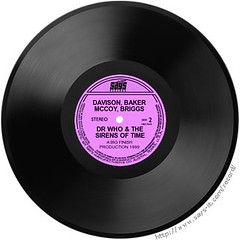 Around the same time came the promise of new Doctor Who on cassette – Big Finish would produce as much as one whole new story every couple of months. How would we ever keep up? CD versions were only available by special mail order. If I remember the press coverage correctly, producer Gary Russell (who I’d met very briefly the previous year) didn’t think audio-drama on CD would catch on, because tape let you stop and start easily.
Around the same time came the promise of new Doctor Who on cassette – Big Finish would produce as much as one whole new story every couple of months. How would we ever keep up? CD versions were only available by special mail order. If I remember the press coverage correctly, producer Gary Russell (who I’d met very briefly the previous year) didn’t think audio-drama on CD would catch on, because tape let you stop and start easily.
Doctor Who Magazine #280 (cover dated 28 July 1999), ran a short article on the small number of Doctor Who sites on the internet. And new Doctor Who on the telly seemed so unthinkable the front cover tells fans to watch Buffy of Babylon 5.
At the risk of getting all Yorkshire, things were even more primitive when the Doctor had last been on the telly. In 1996, I was one of only a handful to use the small room of computers in the Fylde building – and there were serious discussions about whether they should allow students to submit typed essays. As news broke of the Paul McGann TV Movie, my friend D. in Scotland worried I’d miss out, so printed and snail-mailed the latest Who gossip from Shannon Patrick Sullivan’s news page.
Nimbos and I both worked together at a mail order wine company, though in different parts of the building. A customer asked me when he could expect some wine he’d bought in advance of its bottling, and I was directed to Nimbos as the Man Who’d Know.
While Nimbos buzzed through the green-screen database for the answers, I noticed the keys on his desk. And the distinctive, anchor-shaped key ring.
“I know that object,” I said. And he knew I was quoting from Earthshock.
(At an academic thing last month, the Dr outed another fan by spotting the same TARDIS key on his watch-chain. He took great delight in showing it was attached to a Doctor Who fob watch.)
I invited Nimbos to the pub where Doctor Who fans still meet on the first Thursday of each month (I think; I haven’t been in ages). And he invited me to another colleague’s house to watch the first 30-second trailer for The Phantom Menace, which said colleague had spent all night downloading.
Hang on a sec… “Green-screen database”? All night downloading a 30-second trailer?
Such geekery reminds me how much things have changed, and how little the young folk will believe us. In early 1999, the mail order wine company was just daring to consider having its own website – fearing damage to the exemplary reputation it had built up over the phone.
 Around the same time came the promise of new Doctor Who on cassette – Big Finish would produce as much as one whole new story every couple of months. How would we ever keep up? CD versions were only available by special mail order. If I remember the press coverage correctly, producer Gary Russell (who I’d met very briefly the previous year) didn’t think audio-drama on CD would catch on, because tape let you stop and start easily.
Around the same time came the promise of new Doctor Who on cassette – Big Finish would produce as much as one whole new story every couple of months. How would we ever keep up? CD versions were only available by special mail order. If I remember the press coverage correctly, producer Gary Russell (who I’d met very briefly the previous year) didn’t think audio-drama on CD would catch on, because tape let you stop and start easily. Doctor Who Magazine #280 (cover dated 28 July 1999), ran a short article on the small number of Doctor Who sites on the internet. And new Doctor Who on the telly seemed so unthinkable the front cover tells fans to watch Buffy of Babylon 5.
At the risk of getting all Yorkshire, things were even more primitive when the Doctor had last been on the telly. In 1996, I was one of only a handful to use the small room of computers in the Fylde building – and there were serious discussions about whether they should allow students to submit typed essays. As news broke of the Paul McGann TV Movie, my friend D. in Scotland worried I’d miss out, so printed and snail-mailed the latest Who gossip from Shannon Patrick Sullivan’s news page.
Thursday, February 26, 2009
Can we save “dirty” and “stick”?
Fascinated by this news story about the oldest words in English. It’s one avenue of research by Reading University’s evolutionary biology group. As their page on linguistics and cultural evolution says:
My chum Millennium Elephant once nicely explained why tree-branching means there’s no such thing as a “missing link”. In his example, you go back in time 500 years and find that human beings are still human beings. They might be a bit cruder and smellier than folk today, but they’re still our species. Make sure you’ve packed your condoms.
The English language of 500 years ago is likewise a cruder, smellier version of ours. Our speech patterns might raise some eyebrows, but we would probably be understood. Their plays and essays might feel “ye olde worlde” to us now, but we can follow the meaning.
The further back you go, though, the cruder and smellier the people and language become, and the less like us you will find them. About 250,000 years back, the branch of Homo sapiens merges with Homo erectus. (No need for condoms, but shame on you.)
Language changes much quicker than genes: a bit less than 1,000 years back, English splits between Norman French and Anglo-Saxon. But English is made up of all sorts of words nicked from other and earlier languages. So the clever Reading fellows have devised a clever comparative wossname to guesstimate which of our words would still be intelligible to the crude, smelly past. This would be useful if you didn’t have a TARDIS to translate for you (or you did but that bit wasn’t working).
The Word changes gadget lets you set the dematerialisation controls on 200 common, modern words. My Slitheen Excursion is set in 1,500 BC and in Greece. But 3,509 years ago scores 11/200 matches:
Presumably they had their own words for “dirty”, “stick” and “guts”. (Although not a word for “zero” which is a much more recent concept – we didn’t have it when we created the Anno Domini calendar, which is why the millennium celebrations were a year out. I keep meaning to read this book.)
But the news report also suggests that “dirty”, “stick” and “guts” are “likely to die out soon”. Note they don’t define “soon”. It’s discussing words suspected of being 40,000 years-old, so does soon mean next century or next millennia?
Second, if I understand it right it’s not that the words will die out but be superseded. We’ll use other words to say the same things. But which words will we use? Does the research give any idea? Surely these new words will have to be better than the ones we’ve already got.
“Our studies of cultural evolution investigate the idea that human cultures behave as if they were distinct biological species.”As Charlie Darwin worked out (with a splendid sketch on page 36 of notebook B, in 1837-38), evolution means branching development – a great long family tree.
My chum Millennium Elephant once nicely explained why tree-branching means there’s no such thing as a “missing link”. In his example, you go back in time 500 years and find that human beings are still human beings. They might be a bit cruder and smellier than folk today, but they’re still our species. Make sure you’ve packed your condoms.
The English language of 500 years ago is likewise a cruder, smellier version of ours. Our speech patterns might raise some eyebrows, but we would probably be understood. Their plays and essays might feel “ye olde worlde” to us now, but we can follow the meaning.
The further back you go, though, the cruder and smellier the people and language become, and the less like us you will find them. About 250,000 years back, the branch of Homo sapiens merges with Homo erectus. (No need for condoms, but shame on you.)
Language changes much quicker than genes: a bit less than 1,000 years back, English splits between Norman French and Anglo-Saxon. But English is made up of all sorts of words nicked from other and earlier languages. So the clever Reading fellows have devised a clever comparative wossname to guesstimate which of our words would still be intelligible to the crude, smelly past. This would be useful if you didn’t have a TARDIS to translate for you (or you did but that bit wasn’t working).
The Word changes gadget lets you set the dematerialisation controls on 200 common, modern words. My Slitheen Excursion is set in 1,500 BC and in Greece. But 3,509 years ago scores 11/200 matches:
I; weI can see the stickiness of simple, everyday concepts for getting across vital information quickly. But “tongue”?
Name
How; who
One; two; three; four; five
Tongue
Presumably they had their own words for “dirty”, “stick” and “guts”. (Although not a word for “zero” which is a much more recent concept – we didn’t have it when we created the Anno Domini calendar, which is why the millennium celebrations were a year out. I keep meaning to read this book.)
But the news report also suggests that “dirty”, “stick” and “guts” are “likely to die out soon”. Note they don’t define “soon”. It’s discussing words suspected of being 40,000 years-old, so does soon mean next century or next millennia?
Second, if I understand it right it’s not that the words will die out but be superseded. We’ll use other words to say the same things. But which words will we use? Does the research give any idea? Surely these new words will have to be better than the ones we’ve already got.
“Evolution is NOT a process of "mistakes". It's an ongoing series of triumphs over adversity, and every species alive today is a gold medal winner. We're NOT just the recipient of a spoonful of divine generosity. We have worked our way up.”George Orwell’s splendid "Politics and the English language" is a manifesto for more concrete, less pretentious writing. He favours short, Anglo-Saxon words because they’re simpler and more vivid. It would be a shame to lose our guts.Millennium Elephant, “Stupid by design”, 1 March 2008.
Wednesday, February 25, 2009
The Twits
My chum Peter Anghelides is newly blogging, and today has a post about Twitter. I don’t get Twitter. At least, I don’t get what it would do for me.
If I was Stephen Fry, for example, off chasing kakapos round the world and generally being exciting, I can see how a microblog mechanism would be a great way of keeping in with ordinary mortals. On Facebook I get how status updates let you keep in with your friends and relations without all the arduous bother of speaking to them.
And I get that Twitter and Yammer and all these clever things make it easy to address the world in snippets. But the problem is the same one as with any media: what interesting thing will you say?
#Simon is wearing grey socks today
#Simon has drunk three cups of hot water this afternoon, in a Richer Sounds mug
#Simon hopes the moth-man got rid of the moths
#Simon will type this then catch the train home
#Simon is boring himself
At least with blogging you can try to explain and connect and illuminate. (No really, that’s what I think this blog is for, even if I’m only explaining, connecting and illuminating the bleeding obvious to myself.)
But then I’ve also struggled for the last month to come up with that list of 25 interesting things about me which even the Dr has filled out on Facebook. I’m stuck on about 11. It’s probably why I make stuff up for a living.
Wondrous persons like Stephen Fry – and Peter – evangelise twitter. So I watch on baffled but willing to be persuaded. Can someone please explain?
(I like how Peter’s blog lists his written achievements. I should sort something like that for here and do away with that whacking long list in my right-hand navigation.)
If I was Stephen Fry, for example, off chasing kakapos round the world and generally being exciting, I can see how a microblog mechanism would be a great way of keeping in with ordinary mortals. On Facebook I get how status updates let you keep in with your friends and relations without all the arduous bother of speaking to them.
And I get that Twitter and Yammer and all these clever things make it easy to address the world in snippets. But the problem is the same one as with any media: what interesting thing will you say?
#Simon is wearing grey socks today
#Simon has drunk three cups of hot water this afternoon, in a Richer Sounds mug
#Simon hopes the moth-man got rid of the moths
#Simon will type this then catch the train home
#Simon is boring himself
At least with blogging you can try to explain and connect and illuminate. (No really, that’s what I think this blog is for, even if I’m only explaining, connecting and illuminating the bleeding obvious to myself.)
But then I’ve also struggled for the last month to come up with that list of 25 interesting things about me which even the Dr has filled out on Facebook. I’m stuck on about 11. It’s probably why I make stuff up for a living.
Wondrous persons like Stephen Fry – and Peter – evangelise twitter. So I watch on baffled but willing to be persuaded. Can someone please explain?
(I like how Peter’s blog lists his written achievements. I should sort something like that for here and do away with that whacking long list in my right-hand navigation.)
Monday, February 23, 2009
Carpet munchers
Oh the joyous irony. While I was watching Toby’s lepidopterrific show last weekend in America, moths were busy eating my living room.
We’d put a patch of bald carpet by the window down to the rascally cat – it was right by one of the spots where he sleeps and we’ve caught him worrying the carpets elsewhere. But after the new shelves were put in and all our furniture moved around, we’ve discovered there’s a whole series of distinct bald bits.
Googled carpets and moths last night, and found a depressing account with pictures exactly like our problem.
We’re to hoover just before they come for the first go, then empty and rinse-out our bagless Dyson. That’s to stop any larvae surviving in the hoover and reinfecting the flat.
They’ll spray all the carpeted areas of the flat. We then can’t be in the flat for three hours. So me and the vindicated cat will be holing up at the stunt wife’s house round the corner.
Then the exterminators come back 10-14 days later. We’re not to hoover in the meantime, though we can hoover just before they come. Again we need to empty and rinse-out the bagless Dyson. And then we hope that will be that.
(Bar the joys of replacing the carpets, which means moving the brand-new shelves which have just been built on the top of them. And no doubt all sorts of other things that will need to be paid for. Oh yes, I was going to buy a new bed...)
We’d put a patch of bald carpet by the window down to the rascally cat – it was right by one of the spots where he sleeps and we’ve caught him worrying the carpets elsewhere. But after the new shelves were put in and all our furniture moved around, we’ve discovered there’s a whole series of distinct bald bits.
Googled carpets and moths last night, and found a depressing account with pictures exactly like our problem.
“When I closely inspected the carpets I spotted hundreds of eggs along the edges of the carpet under a desk. The eggs are tiny - much smaller than a pinhead … When I lifted the carpet there were thousands more along under the skirting board.”That post is from nearly a year ago, but a comment from the administrator posted only on Saturday says,“Clothes moths attack!”, reviewmylife, 14 May 2008.
“No, we never managed to get rid of the moths :( My friend moved out of the flat. I don’t know what has happened about the moths since.”So I called Rentokil at 9 am this morning, and their local exterminator just called me back. It’s not the moths as much as the larvae that are eating through our furnishings, and we need a two-part spray.
We’re to hoover just before they come for the first go, then empty and rinse-out our bagless Dyson. That’s to stop any larvae surviving in the hoover and reinfecting the flat.
They’ll spray all the carpeted areas of the flat. We then can’t be in the flat for three hours. So me and the vindicated cat will be holing up at the stunt wife’s house round the corner.
Then the exterminators come back 10-14 days later. We’re not to hoover in the meantime, though we can hoover just before they come. Again we need to empty and rinse-out the bagless Dyson. And then we hope that will be that.
(Bar the joys of replacing the carpets, which means moving the brand-new shelves which have just been built on the top of them. And no doubt all sorts of other things that will need to be paid for. Oh yes, I was going to buy a new bed...)
Friday, February 20, 2009
Technological marvels
Here are some things I've been sent in the last few days.
The Dr sends this Gigapan of Obama inaugaration, where you can zoom almost right up his nostrils.
Peter sends this video of people falling off mountains without parachutes which laughs in the face of The Spy Who Loved Me, but I suspect might be in a future Bond film.
Jonny has been blogging every day of this year, but reminds me it's no longer secret.
And, as if science cannot create anything more wondrous, there's a Lego Admiral Ackbar and a Boba Fett hoodie! (I saw the latter for real last weekend, as modelled by my new pal Ha-vee-air Gree-joe Marks-watch.)
The Dr sends this Gigapan of Obama inaugaration, where you can zoom almost right up his nostrils.
Peter sends this video of people falling off mountains without parachutes which laughs in the face of The Spy Who Loved Me, but I suspect might be in a future Bond film.
Jonny has been blogging every day of this year, but reminds me it's no longer secret.
And, as if science cannot create anything more wondrous, there's a Lego Admiral Ackbar and a Boba Fett hoodie! (I saw the latter for real last weekend, as modelled by my new pal Ha-vee-air Gree-joe Marks-watch.)
Thursday, February 19, 2009
Gallifrey and nine
Gallifrey was exhausting and brilliant and silly. Saw a whole bundle of old chums and made a great glutch of new ones. Flogged product and drank one or two ales. I said at the closing ceremony (where you have to say something) that I wished it could be Gallifrey every day. Which would be fun, but I wouldn’t long survive.
James Moran has made a number of very serious allegations about me, but surely there’d be pictures. And if there were pictures, surely there’d be evidence of Photoshop in them. I deny all accusations.
Didn’t sleep a wink on the flight home, and my entertainment system wasn’t working either. So I sat in the darkness and thought Thoughts that may one day become things I can brag about. Slowly the hours ticked by.
Eventually we plonked down in Heathrow. Turns out we shared our flight home with the Hoff, and dared each other to ask for pictures with him while we waited for our baggage. Don’t think we actually did – but by then my brain was drooling out my eyes. Out through customs to fall into me and M.’s waiting taxi. We slalomed through west and south London and then finally we were home.
Slept. And slept and slept. And woke up not knowing what day it was or where I’d left my head. Confused and stupid (no, more than usual) have got myself back into work. There’s been quick rewrites on a thing as-yet-unannounced and rewrites requested on something else. Went to the Post Office and the bank and fell through two splendid episodes of Being Human and nearly 300 emails. And then started sneezing; think I picked up a cold on the plane home. Dammit.
The Dr is, of course, delighted by the state I’m in. The whole point of jetting off across the pond without her was to come home relaxed, refreshed and skippy. Not snuffling and stupid and snoring. But I’m taking her out tonight for a posh tea, so she can’t complain.
Because nine years ago this evening I stumbled over to the Dr to tell her she was lovely. And dammit, she still is. The lesson is, my young padawans, that if you fancy someone, tell them.
James Moran has made a number of very serious allegations about me, but surely there’d be pictures. And if there were pictures, surely there’d be evidence of Photoshop in them. I deny all accusations.
Didn’t sleep a wink on the flight home, and my entertainment system wasn’t working either. So I sat in the darkness and thought Thoughts that may one day become things I can brag about. Slowly the hours ticked by.
Eventually we plonked down in Heathrow. Turns out we shared our flight home with the Hoff, and dared each other to ask for pictures with him while we waited for our baggage. Don’t think we actually did – but by then my brain was drooling out my eyes. Out through customs to fall into me and M.’s waiting taxi. We slalomed through west and south London and then finally we were home.
Slept. And slept and slept. And woke up not knowing what day it was or where I’d left my head. Confused and stupid (no, more than usual) have got myself back into work. There’s been quick rewrites on a thing as-yet-unannounced and rewrites requested on something else. Went to the Post Office and the bank and fell through two splendid episodes of Being Human and nearly 300 emails. And then started sneezing; think I picked up a cold on the plane home. Dammit.
The Dr is, of course, delighted by the state I’m in. The whole point of jetting off across the pond without her was to come home relaxed, refreshed and skippy. Not snuffling and stupid and snoring. But I’m taking her out tonight for a posh tea, so she can’t complain.
Because nine years ago this evening I stumbled over to the Dr to tell her she was lovely. And dammit, she still is. The lesson is, my young padawans, that if you fancy someone, tell them.
Labels:
america,
chums,
dr,
droo,
public engagements,
snot,
things as-yet unannounced
Thursday, February 12, 2009
Golden Gate
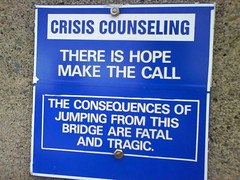 Spent the day at San Francisco's fantabulous Exploratorium, and then walked from there, across the Golden Gate Bridge and into Sausolito. Knackering, wet and windy - and muggins forgot to take a coat.
Spent the day at San Francisco's fantabulous Exploratorium, and then walked from there, across the Golden Gate Bridge and into Sausolito. Knackering, wet and windy - and muggins forgot to take a coat.Off to dinner now as a thank you to our landlords, then M. and I fly to LA tomorrow for a weekend's geeky larking.
Wednesday, February 11, 2009
The long walk
The stunt wife (M.) and I were out of the apartment at half eight this morning to make our 10am boat trip to Alcatraz - see my photos of Alcatraz. Were there for two hours, then had an ENORMOUS lunch of clam chowder soup followed by very rare tuna steak. Om nom nom.
We then walked to the cable car stop, cabled up the absurdly steep hills to the Cable Car Museum, and generally wowed at the big turney wheels. Next, we clambered down the hill to Union Square, had a coffee, and then trekked to a shop called Giant Robot, down 17th street and back to our pad. Got in just after six - a three-and-a-bit hour walk. All sorts of wild buildings and sights along the way. The photos of the walk are tagged "francisco", or you browse through the whole damn lot via the useful tag "san".
See how easy I make it? (I didn't just stuff up the tagging like a fool.)
Tomorrow, close up on the Golden Gate Bridge. And my feet hurt.
We then walked to the cable car stop, cabled up the absurdly steep hills to the Cable Car Museum, and generally wowed at the big turney wheels. Next, we clambered down the hill to Union Square, had a coffee, and then trekked to a shop called Giant Robot, down 17th street and back to our pad. Got in just after six - a three-and-a-bit hour walk. All sorts of wild buildings and sights along the way. The photos of the walk are tagged "francisco", or you browse through the whole damn lot via the useful tag "san".
See how easy I make it? (I didn't just stuff up the tagging like a fool.)
Tomorrow, close up on the Golden Gate Bridge. And my feet hurt.
Tuesday, February 10, 2009
Vegas and the Hoover Dam
Having a lovely time. Today's the first day we've not had rain since I got here; and I've spent all day indoors finishing rewrites. But now I am FREE - and can do Alcatraz and the Cable Car Museum and the Golden Gate Bridge before knocking down to LA for the weekend.
Fab weekend in Vegas though: will try to write up my notes on the place before long. But in the meantime on Flickr, there are photos of Vegas and photos of the Hoover Dam.
Friday, February 06, 2009
Flowers in my hair
Hello from rainy San Francisco. Out the window there is a lemon tree in the garden. To my right, D. is transforming between a mammoth, a dragon and a.. something with shoulder pads in World of Warcraft.
Took exactly 24 hours to get here, door-to-door, coming via Los Angeles. On the plane I watched Burn After Reading (silly, twisty nonsense), Man on Wire (brilliant and mad and terrifying), Tropic Thunder (stupid fun) and Clone Wars (indulgent, stupid toss).
Got rewrites of my Primeval novel to finish, and proofs of my Slitheen book to get through. Also got to see Alcatraz and the cable car museum. And tomorrow we are off to Vegas.
Monday, February 02, 2009
Snow, shelves, Sherwood
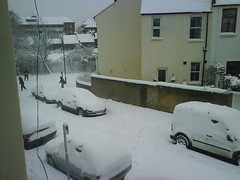 Snowed in. There are no trains running so I can't get to work. It's like being back in Chicago. Only here we're all taking a duvet day. Means I've a chance to catch up on the hundred things I'm racing to finish. The Dr mutters darkly about how this time next week I'll be San Francisco.
Snowed in. There are no trains running so I can't get to work. It's like being back in Chicago. Only here we're all taking a duvet day. Means I've a chance to catch up on the hundred things I'm racing to finish. The Dr mutters darkly about how this time next week I'll be San Francisco.I don't tell her I might be in Vegas.
The inclement weather has scuppered the plan to have new shelves built today; the Man can't hope to reach us. Which is a bother 'cos the Dr and R. spent all yesterday clearing the old shelves out of the way. There are books stacked all over everywhere now, and the old shelves themselves were gone within minutes of being put up on Freecycle. So we have a strange and echoing living room, a good foot wider to the right.
We sat in the tinny-sounding space last night to watch Attenborough's programme on Darwin and the Tree of Life, and then Being Human. Bah! that both shows were on at the same time. Bah! that it took an hour for Being Human to be up on iPlayer. But woo! for such splendid telly. And Moses Jones tonight.
Nimbos and the Dr are thinking of venturing out to take photos and build snowpersons later. I have work to get on with. Spent the weekend finishing something as-yet unannounced. But something I can now speak of is Robin Hood: The Siege. It's a talking book read by the apparently quite dishy Richard Armitage – the Dr has made known her approval of this assignment. The story is set during the BBC TV show's forthcoming third series. Release dates will depend on when that's shown...
Right. Plenty to get on with. But I'm going to go back to bed.
Labels:
books,
building works,
snow,
stuff written,
things as-yet unannounced
Saturday, January 31, 2009
Fmoo
My chums at the Herald asked me and some other sage persons to write 100 words on a favourite children's book. I've chosen "The Hermit and the Bear" by John Yeoman, illustrated by Quentin Blake (Andre Deutsch, London 1984).
 (I thought better of best-cover-ever Death to the Daleks, or of best-opening-line ever Dalek Invasion of Earth ("Through the ruin of a city stalked the ruin of a man"). And I could also have gone for Roald Dahl's The Magic Finger or The Twits, or Mr Silly, but they should be set texts for kids, so I chose one you might not have heard of.)
(I thought better of best-cover-ever Death to the Daleks, or of best-opening-line ever Dalek Invasion of Earth ("Through the ruin of a city stalked the ruin of a man"). And I could also have gone for Roald Dahl's The Magic Finger or The Twits, or Mr Silly, but they should be set texts for kids, so I chose one you might not have heard of.)
Apparently no-less-august a person than Brian Cant read "The Hermit and the Bear" for Jackanory in March 1988. Like Tom Baker reading "The Iron Man", Rik Mayall reading "George's Marvellous Medicine" and the million-and-one books read by Bernard Cribbens, these things should be made available for download - perhaps just as MP3 sound files.
 (I thought better of best-cover-ever Death to the Daleks, or of best-opening-line ever Dalek Invasion of Earth ("Through the ruin of a city stalked the ruin of a man"). And I could also have gone for Roald Dahl's The Magic Finger or The Twits, or Mr Silly, but they should be set texts for kids, so I chose one you might not have heard of.)
(I thought better of best-cover-ever Death to the Daleks, or of best-opening-line ever Dalek Invasion of Earth ("Through the ruin of a city stalked the ruin of a man"). And I could also have gone for Roald Dahl's The Magic Finger or The Twits, or Mr Silly, but they should be set texts for kids, so I chose one you might not have heard of.)Apparently no-less-august a person than Brian Cant read "The Hermit and the Bear" for Jackanory in March 1988. Like Tom Baker reading "The Iron Man", Rik Mayall reading "George's Marvellous Medicine" and the million-and-one books read by Bernard Cribbens, these things should be made available for download - perhaps just as MP3 sound files.
Friday, January 30, 2009
Claque!
(No, not kklak!)
To the Coach and Horses on Tuesday (or to a Coach and Horses, since there’s a whole myriad gang of them in London), where m’colleague Will Howells was one of 11 brave entrants in that night’s heat of the Laughing Horse New Act of the Year 2009 competition.
I hate having to stand up and speak in front of people, and thought being a writer would mean someone else would always do that bit. But part of the gig is flogging the product and I’ve developed a technique of talking too fast and about not very much and so generally sort of scrape through.
Which means I’m in awe of these brave ladies and gentlemen who dared try their comedy on people they don’t even know. There’s no grey area in telling a joke: people either laugh or sit in hollow silence. Even a slight titter or knowing smile can cut the teller apart. It’s excruciating enough with an audience already on your side.
Each turn got exactly five minutes before being dragged back into the darkness. Will was, I’m relieved to say, quite brilliant – and easily leapt through into the next round of the contest.
There were several very good other acts, too. And some that failed to ignite our cruel mob. When I should have been fighting to meet pressing deadlines, I’ve been trying to fathom just why.
1. Working the audience
Several acts started with a cheery, “How you doing, all right?” The smallish audience didn’t have the anonymity to call back, so met the comic with an uncomfortable murmur. You could see it the comics’ eyes: stood there in front of the microphone and it already not working.
2. Watch the opposition
That happening to one comic would have been bad enough, but it happened again and again. So, watch the other acts and don’t do what they didn’t make work. And if the audience doesn’t respond to your first cheery hello, don’t then spend the rest of your act asking the audience questions: “Who’s in love?”, “Who’s from London?”, “Who here has their own nose?” Answer came there none.
3. Why do women wear make-up and perfume?
There were a lot of jokes at the expense of women – about shopping and smear tests and sex. When these worked at all they were being told by women. It helps to get us on side if you’re mocking yourself rather than pointing at other people.
4. Rude ≠ funny
There were also a lot of jokes aimed at shocking us – about bowel movements or the evils of women. Shocks are like exclamation marks; they work if you use them with caution. Too much and you deaden their impact. You might as well write out your act in the Comic Sans typeface to show us how cray-zee it is.
5. Keep us busy
Some acts made observations that weren’t exactly funny. Others spent their allotted five minutes setting up one joke. We need a steady stream of funny bits; small woofs peppered between the big ones. Keep us engaged and surprised and we will be grateful.
6. Relevant
A lot of acts tried to be topical – with mentions of Obama or the credit crunch. At worst, these just felt tacked-on to the pre-arranged act, or just obvious and lame. Every comic on the telly, every paper, every wag at work, is doing their spin on the news. So your joke has to be something amazing to stand above the crowd.
7. Funny = smart
There’s an important difference between silly and stupid. A lot of comedy seems to work on the basis of “Isn’t subject X stupid?” Which subject X is, especially when you wilfully distort it. The late Douglas Adams, who made his name fondly mocking science and philosophy, found himself falling out of love with comedy as a result of, in his own words:
To the Coach and Horses on Tuesday (or to a Coach and Horses, since there’s a whole myriad gang of them in London), where m’colleague Will Howells was one of 11 brave entrants in that night’s heat of the Laughing Horse New Act of the Year 2009 competition.
I hate having to stand up and speak in front of people, and thought being a writer would mean someone else would always do that bit. But part of the gig is flogging the product and I’ve developed a technique of talking too fast and about not very much and so generally sort of scrape through.
Which means I’m in awe of these brave ladies and gentlemen who dared try their comedy on people they don’t even know. There’s no grey area in telling a joke: people either laugh or sit in hollow silence. Even a slight titter or knowing smile can cut the teller apart. It’s excruciating enough with an audience already on your side.
Each turn got exactly five minutes before being dragged back into the darkness. Will was, I’m relieved to say, quite brilliant – and easily leapt through into the next round of the contest.
There were several very good other acts, too. And some that failed to ignite our cruel mob. When I should have been fighting to meet pressing deadlines, I’ve been trying to fathom just why.
1. Working the audience
Several acts started with a cheery, “How you doing, all right?” The smallish audience didn’t have the anonymity to call back, so met the comic with an uncomfortable murmur. You could see it the comics’ eyes: stood there in front of the microphone and it already not working.
2. Watch the opposition
That happening to one comic would have been bad enough, but it happened again and again. So, watch the other acts and don’t do what they didn’t make work. And if the audience doesn’t respond to your first cheery hello, don’t then spend the rest of your act asking the audience questions: “Who’s in love?”, “Who’s from London?”, “Who here has their own nose?” Answer came there none.
3. Why do women wear make-up and perfume?
There were a lot of jokes at the expense of women – about shopping and smear tests and sex. When these worked at all they were being told by women. It helps to get us on side if you’re mocking yourself rather than pointing at other people.
4. Rude ≠ funny
There were also a lot of jokes aimed at shocking us – about bowel movements or the evils of women. Shocks are like exclamation marks; they work if you use them with caution. Too much and you deaden their impact. You might as well write out your act in the Comic Sans typeface to show us how cray-zee it is.
5. Keep us busy
Some acts made observations that weren’t exactly funny. Others spent their allotted five minutes setting up one joke. We need a steady stream of funny bits; small woofs peppered between the big ones. Keep us engaged and surprised and we will be grateful.
6. Relevant
A lot of acts tried to be topical – with mentions of Obama or the credit crunch. At worst, these just felt tacked-on to the pre-arranged act, or just obvious and lame. Every comic on the telly, every paper, every wag at work, is doing their spin on the news. So your joke has to be something amazing to stand above the crowd.
7. Funny = smart
There’s an important difference between silly and stupid. A lot of comedy seems to work on the basis of “Isn’t subject X stupid?” Which subject X is, especially when you wilfully distort it. The late Douglas Adams, who made his name fondly mocking science and philosophy, found himself falling out of love with comedy as a result of, in his own words:
“hearing a stand-up comedian make the following observation. "These scientists eh? They're so stupid! You know those black box flight recorders they put on aeroplanes? And you know they're meant to be indestructible? It's always the thing that doesn't get smashed? So why don't they make the planes out of the same stuff?" The audience roared with laughter at how stupid scientists were, how they couldn't think their way out of a paper bag, but I sat feeling uncomfortable. Was I just being pedantic to feel that the joke didn't really work because flight recorders are made out titanium and that if you made planes out of titanium rather than aluminium they'd be far too heavy to get off the ground in the first place?”Douglas Adams, “The hitchhiker's guide to the 21st century”, The Independent, 19 December 2000.
Subscribe to:
Comments (Atom)

